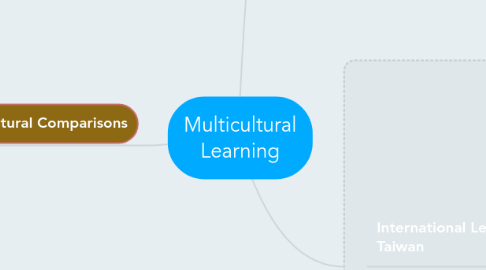
1. Cross-Cultural Comparisons
1.1. EAST ASIA
1.1.1. Academics/Learning
1.1.1.1. Rote Memorisation
1.1.1.2. Teacher Focused
1.1.1.3. Language Study as Theory/Grammar
1.1.1.4. Passive
1.1.1.5. Curriculum
1.1.1.5.1. Chinese
1.1.1.5.2. Science
1.1.1.5.3. English
1.1.1.5.4. Math
1.1.1.6. Learning Goals
1.1.1.6.1. Test Scores
1.1.1.6.2. Matriculation to schools with high standing
1.1.1.7. Perception of Teachers as Profession
1.1.1.7.1. Extremely highly respected in Chinese society, due to the strong connection between family and academics
1.1.2. Ethnicity
1.1.2.1. Han Chinese
1.1.3. Language
1.1.3.1. Mandarin Chinese/Taiwanese
1.1.4. Cultural Identity
1.1.4.1. Collectivist/Confucianism/Monocultural
1.1.5. Family Influence
1.1.5.1. Extremely Strong ties to family
1.1.5.2. Academic Success reflects directly on family pride, responsibility to child's learning
1.2. NORTH AMERICA
1.2.1. Cultural Identity
1.2.1.1. Individualistic/Self Actualised
1.2.2. Language
1.2.2.1. English/French
1.2.3. Ethnicity
1.2.3.1. English/Irish/Scottish/French/First Nations
1.2.4. Academics/ Learning
1.2.4.1. Inquiry Based
1.2.4.2. Student Focused
1.2.4.3. Language Study for Communicative Purposes
1.2.4.4. Active
1.2.4.5. Curriculum
1.2.4.5.1. Social Studies
1.2.4.5.2. Physical Education
1.2.4.5.3. Health
1.2.4.5.4. Art
1.2.4.5.5. Music
1.2.4.5.6. Science
1.2.4.5.7. Geography
1.2.4.5.8. History
1.2.4.5.9. Mathematics
1.2.4.5.10. Media Arts
1.2.4.6. Creativity
1.2.4.6.1. Often promoted as part of individualism/self actualisation/ going against status quo
1.2.4.7. Learning Goals
1.2.4.7.1. Self Actualisation
1.2.4.7.2. Life Skills
1.2.4.7.3. Socially Aware
1.2.4.7.4. Social Reconstructionism
1.2.4.8. Perception of Teachers in North American Society
1.2.4.8.1. Perceived as unsuccessful people within a corporate/capitalist milieux
1.2.4.8.2. Not as respected as in Asian society by the general population, due to the disconnect between family and school
1.2.5. Family Influence
1.2.5.1. Loose relationships where children are expected to move out of the home at 18
1.2.5.2. Weak link between academic success and parental responsibility: parents usually blame school or teachers
2. Intercultural Interaction
2.1. Family Life
2.1.1. Raising Children from a Multilingual/ Bicultural Family
2.1.1.1. Promoting Multilingualism
2.1.1.2. Respecting Both Cultures
2.1.1.3. Language training
2.1.1.3.1. access to L1 of both parents
2.1.1.4. Academics
2.1.1.4.1. multilingual development
2.1.1.4.2. analysing relationship between child's multilingual development and their academic performance
2.1.1.5. cultural identity evolution
2.1.1.5.1. help child appreciate their bicultural background
2.2. Professional Life
2.2.1. Promoting Intercultural Communicative Competency
2.2.1.1. discouraging ethnocentricity
2.2.1.2. Bridging East and West
2.2.2. Teaching Students from East Asia
2.2.2.1. Linguistic Skills
2.2.2.2. Intercultural Skills
2.2.2.2.1. Empathy
2.2.3. Training Teachers from East Asian backgrounds in the latest language learning methodology
2.2.3.1. exchanging of pedagogical ideas
2.2.3.1.1. promoting language learning as communicative
2.2.3.2. helping teachers understand to lower the Affective Filter
3. International Learning Possibilities in Taiwan
3.1. Universities with International Language Departments
3.2. International Schools
3.3. International Schools with IB programs
3.4. Private High Schools with International Teachers
3.5. Public High Schools with International Teachers
3.5.1. New Topic
